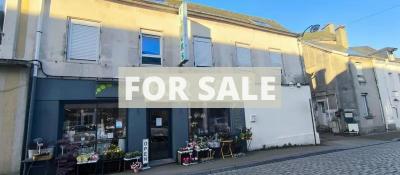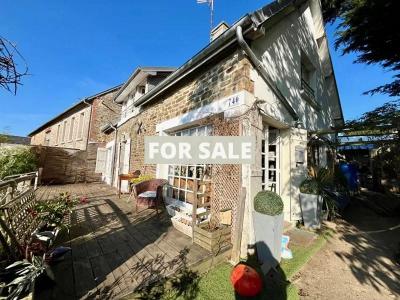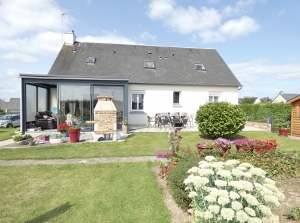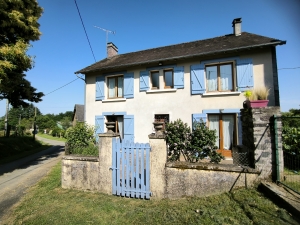Let us take a look at the interesting and historic city of Lisieux in Pays d'Auge area of Calvados, Lower Normandy.
Lisieux is only 30 to 40 minutes from the ports of Caen and Le Harve, it is the main town of the Pays d'Auge (more on this later) in the department of Calvados in the region of Lower Normandy and it is a good place to get to know a little about French cheeses and ciders. There are large street markets on Wednesdays and Saturdays where you can buy anything from French cheese to French clothes.
A lot of people, however, come to Lisieux as a place of pilgrimage based around the cult of St Thérèse, the most popular French spiritual figure of the last hundred years. Passivity, self-effacement and a self-denial that verged on masochism were her trademarks, and she is honoured by the gaudy and gigantic Basilique de Ste-Thérèse, completed in 1954 on a slope to the southwest of the town centre. The huge modern mosaics that decorate the nave are undeniably impressive. The faithful and tourists alike can ride on a "petit train" around the holiest sites, which include the restrained, by comparison to the basilique, Cathédrale St-Pierre.
Properties in and around Lisieux that are generally in high demand are the traditionally constructed stone or colombage (half-timbered) styles. Other styles are readily available at a better price as the colombage properties tend to demand a higher price but you get a lot of charm and property for your money.
Basilica of Sainte-Thérèse de Lisieux.
The Basilica of Sainte-Thérèse de Lisieux was constructed in honour of Sainte-Thérèse de Lisieux, who was beatified in 1923 and canonized in 1925. It was built for pilgrims who came in increasing numbers to venerate the new saint in the town where she had lived and died.
Château de Saint-Germain-de-Livet.
As its name indicates, the Château de Saint-Germain-de-Livet is situated in the commune of Saint-Germain-de-Livet. It is to be found opposite the village church which dates from the 19th century. The château has been owned by the town of Lisieux since 1958 when it was donated by the Riesener family.
From an architectural point of view the château comprises a half-timbered manor dating from the 15th century and a glazed brick and stone building from the Pré-d'Auge dating from the end of the 16th century.
The chateau combines medieval and renaissance elements and is surrounded by a moat and a peacock garden.
Saint-Pierre Cathedral.
Lisieux’s Saint-Pierre Cathedral is a rare monument which survived the 1944 allied bombardment. Even though the cathedral has been around since the 6th century, the church we see today must have been constructed between 1160 and 1230 by Bishop Arnoul.
From the outset, the architect designed quadripartite rib vaults and flying buttresses, making it one of Normandy’s first gothic buildings. The nave is fairly austere and is inspired by the Gothic style of the Ile de France whereas the most recent parts of the building were constructed in the 18th century (the chevet, the lantern tower and the western façade) in Norman style.
It is wrongly claimed that Henry, the Count of Anjou, the Duke of Normandy and the future king of England married Eleanor of Aquitaine at the cathedral in 1152. Having been involved in the trial of Joan of Arc, Pierre Cauchon was in fact named as Bishop of Lisieux in 1432 and is buried there.
A little about Ste-Thérèse of Lisieux 1873 - 1897.
Generations of Catholics have admired this young saint, called her the "Little Flower", and found in her short life more inspiration for own lives than in volumes by theologians.
Yet Therese died when she was 24, after having lived as cloistered Carmelite for less than ten years. She never went on missions, never founded a religious order, never performed great works. The only book of hers, published after her death, was an brief edited version of her journal called "Story of a Soul." (Collections of her letters and restored versions of her journals have been published recently.) But within 28 years of her death, the public demand was so great that she was canonized.
Over the years, some modern Catholics have turned away from her because they associate her with over- sentimentalised piety and yet the message she has for us is still as compelling and simple as it was almost a century ago.
Therese was born in France in 1873, the pampered daughter of a mother who had wanted to be a saint and a father who had wanted to be monk. The two had got married but determined they would be celibate until a priest told them that was not how God wanted a marriage to work! They must have followed his advice very well because they had nine children. The five children who lived were all daughters who were close all their lives.
Tragedy and loss came quickly to Therese when her mother died of breast cancer when she was four and a half years old. Her sixteen year old sister Pauline became her second mother -- which made the second loss even worse when Pauline entered the Carmelite convent five years later. A few months later, Therese became so ill with a fever that people thought she was dying.
The worst part of it for Therese was all the people sitting around her bed staring at her like, she said, "a string of onions." When Therese saw her sisters praying to statue of Mary in her room, Therese also prayed. She saw Mary smile at her and suddenly she was cured. She tried to keep the grace of the cure secret but people found out and badgered her with questions about what Mary was wearing, what she looked like. When she refused to give in to their curiosity, they passed the story that she had made the whole thing up.
Pays d'Auge
The rolling hills and green twisting valleys of the Pays d'Auge stretch south of the cathedral town of Lisieux and are scattered with magnificent half-timbered manor houses. The pastures here are the lushest in the province, their produce the world-famous cheeses of Camembert, Pont L'Évêque and possibly the smelliest of them all, Livarot . And beside these are hectares of orchards, yielding the best of Norman ciders, both apple (pomme) and pear (poiré), as well as Calvados apple brandy which should come with a health warning so please drink in moderation!
Learn more about "Whats On" in and around Lisieux.
Basilique de Ste-Thérèse.
Cathédrale St-Pierre.
Le Grand Hotel.
Blog submitted by: Sharon at Cle France.











